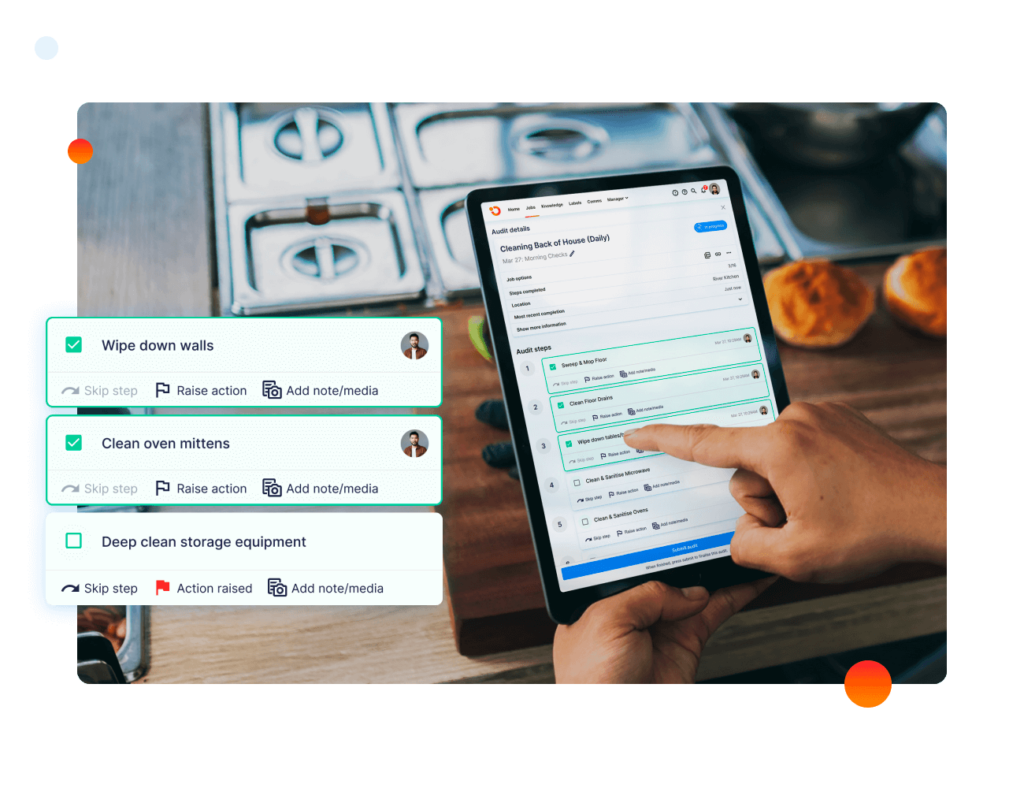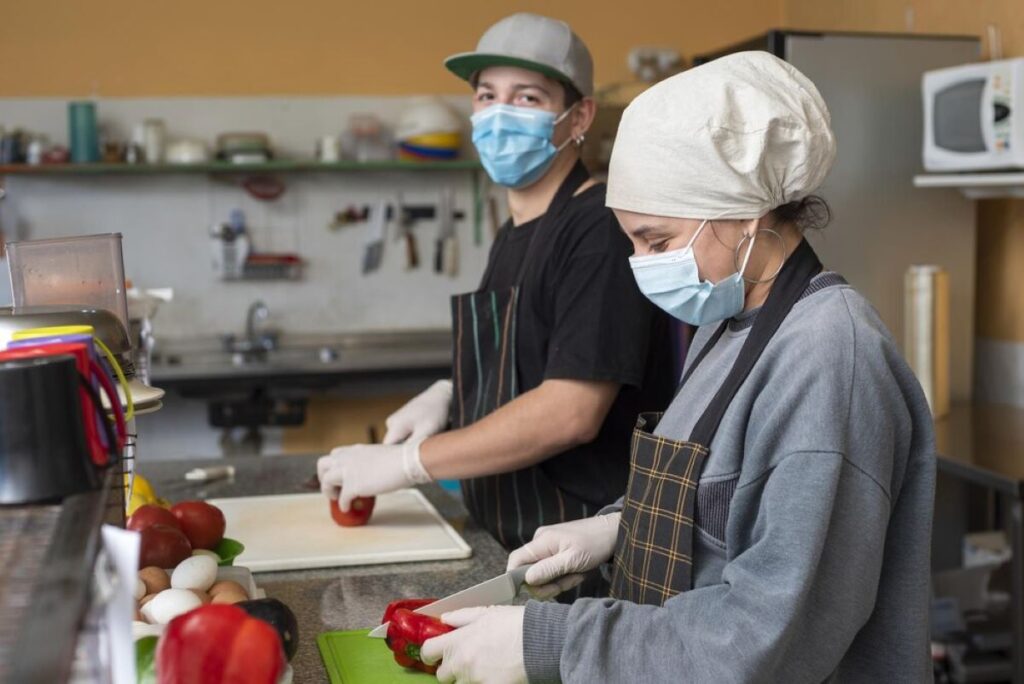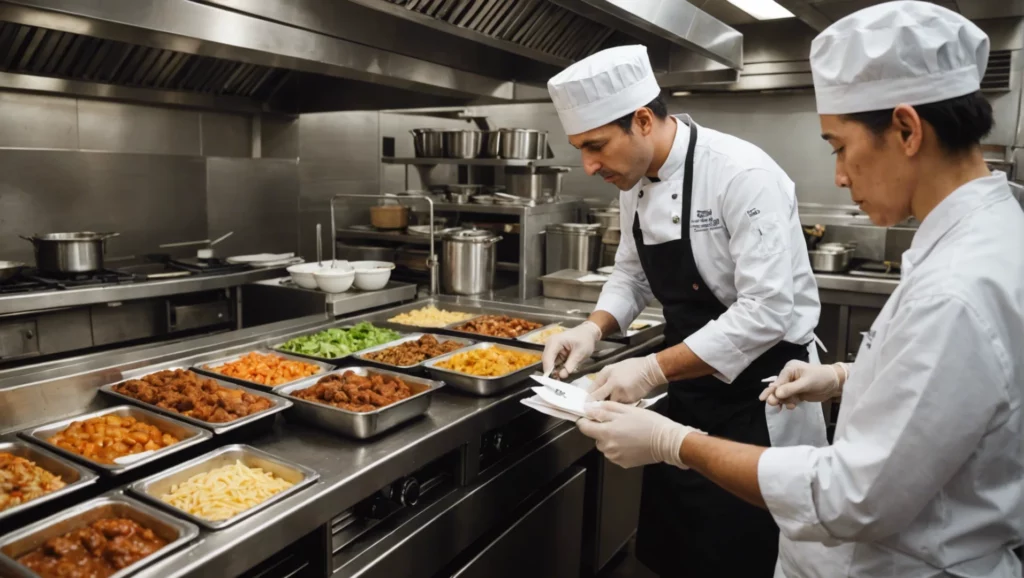The food industry is undergoing rapid changes, facing challenges such as managing new types of food products and dealing with climate-related disruptions in the supply chain. To address these issues, food safety compliance software in 2025 needs to go beyond basic record-keeping and become intelligent systems that can predict risks before they happen.
The need for compliance software has never been more critical. Traditional paper-based systems cannot keep up with today’s complex regulatory environment, where precise allergen tracking is required by regulations like Natasha’s Law and consumers expect complete transparency in the supply chain. Businesses that do not embrace advanced compliance tools risk expensive recalls, regulatory fines, and irreversible harm to their reputation.
Technology is also changing what businesses should look for in their compliance platforms. Artificial intelligence can now predict contamination risks, blockchain technology ensures product authenticity throughout global supply chains, and cloud-based systems offer real-time monitoring from any location. At the same time, regulatory bodies are tightening their standards and demanding software that can quickly adapt to new requirements without disrupting operations.
This combination of technological advancements and stricter regulations means that choosing the right software is not just about meeting current standards—it is also about preparing your operations for future challenges. In this article, we will discuss the key features that will set apart the best food safety compliance software in 2025.

What Emerging Technologies Should Food Safety Software Incorporate?
AI in food safety transforms how businesses anticipate and prevent contamination events before they occur. Machine learning algorithms analyse historical data patterns, environmental conditions, and operational variables to predict potential hazards with remarkable accuracy. This machine learning predictive management approach enables food businesses to shift from reactive crisis management to proactive risk mitigation, reducing costly recalls and protecting consumer health.
Blockchain traceability provides an immutable digital ledger that tracks every ingredient from origin to final product. Each transaction—from farm harvest to processing facility to distribution centre—creates a permanent, tamper-proof record. When contamination occurs, businesses can identify the exact source within minutes rather than days, containing outbreaks faster and minimising product waste. The technology also combats food fraud by verifying authenticity claims about organic certification, geographical origin, or sustainable sourcing practices.
Pathogen detection technologies have evolved beyond traditional laboratory testing. Portable devices now deliver results in hours instead of days, allowing real-time decision-making on production floors. Whole genome sequencing (WGS) identifies specific bacterial strains with precision, enabling targeted interventions and detailed outbreak investigations. Software that integrates these advanced detection methods creates a comprehensive safety net, combining rapid screening capabilities with sophisticated genetic analysis for thorough contamination tracking and prevention strategies. Moreover, the integration of advanced pathogen detection technologies into food safety software further enhances its effectiveness by providing rapid and accurate results that are crucial for timely decision-making.
How Does Cloud-Based Technology Enhance Compliance Management?
Cloud-based food safety platforms transform compliance management by centralizing all safety data in one accessible location. Teams can access critical information—from temperature logs to supplier certifications—from any device, anywhere, eliminating the delays and confusion of scattered paper records or local servers.
1. Centralized Data Management
Centralized data management creates a single source of truth for your entire operation. When inspectors arrive, every document, record, and compliance certificate lives in one organized digital space. This eliminates the frantic search through filing cabinets or multiple spreadsheets that plague traditional systems.
2. Automation Features
Automation features built into cloud platforms handle repetitive compliance tasks without human intervention:
- Automatic temperature logging from connected sensors
- Scheduled cleaning reminders sent directly to staff devices
- Expiry date alerts for ingredients and products
- Compliance checklist generation based on regulatory requirements
3. Real-Time Monitoring
Real-time monitoring capabilities give managers instant visibility into compliance status across multiple locations. Dashboard alerts flag potential issues—like a refrigerator temperature spike or a missed cleaning task—before they escalate into violations.
4. Audit Readiness Automation
Audit readiness automation means your operation stays inspection-ready every day. Cloud systems automatically organize records chronologically, generate required reports, and maintain complete audit trails. When regulators request documentation, you can produce comprehensive records in minutes rather than hours or days.
More about: Best Food Safety Manager Software for HACCP and ISO Standards
How Should Software Support Novel Foods and Emerging Industry Trends?
Managing Safety Protocols for Novel Foods
Novel foods compliance requires software that can handle safety protocols for products that weren’t around ten years ago. This includes lab-grown meats, insect-based proteins, and plant-based alternatives, each of which has its own specific microbiological and chemical hazards that need specialised monitoring systems. The software must be able to address these unique risks while still upholding the same strict standards applied to traditional foods.
Tracking Cellular Agriculture Parameters
Cellular agriculture safety presents new challenges for compliance systems. Cultivated meat products need tracking of cell cultures, growth media components, and bioreactor conditions—factors that traditional food safety software was not built to track. The ideal platform should have flexible data fields and assessment templates that can capture these new production variables without forcing them into outdated categories.
Adapting to Rapidly Changing Regulatory Frameworks
Regulatory frameworks for emerging food product regulations are constantly changing as authorities around the world establish guidelines for innovative ingredients. The software must be able to quickly update compliance checklists, hazard analysis protocols, and documentation requirements without needing complete system overhauls. Version control features will ensure teams are always working with the latest regulatory standards while still keeping historical records for audit purposes.
Supporting Sector-Specific Needs
The ability to create industry-specific modules sets apart basic compliance tools from platforms that are prepared for the food landscape of 2025. Look for systems that offer modular architecture where businesses can activate specialised features—such as precision fermentation monitoring or algae cultivation tracking—as their product range expands into new areas.
What Features Support Allergen Management and Regulatory Compliance?
Allergen management software must provide automated labeling tools that generate compliant allergen declarations meeting Natasha’s Law compliance standards. The software should create clear, consistent labels displaying all 14 major allergens in bold or highlighted text, automatically updating ingredient databases when suppliers change formulations. Digital recipe management systems calculate allergen presence across all menu items or products, flagging potential cross-contamination risks during production planning.
To ensure adherence to allergen guidance for food businesses, staff training modules embedded within compliance platforms deliver interactive allergen awareness courses, tracking completion rates and competency assessments for each team member. These modules should include:
- Visual guides for identifying allergen-containing ingredients
- Protocols for handling customer allergen enquiries
- Step-by-step procedures for preventing cross-contact
- Regular knowledge refreshers with certification tracking
Allergen labeling tools extend beyond packaging to include digital menu boards and point-of-sale systems, ensuring consistent communication across all customer touchpoints. The software maintains audit trails documenting when labels were generated, who approved them, and which ingredient specifications were used.
Color-coded equipment tracking features assign specific utensils, cutting boards, and preparation areas to allergen-free zones. The system sends alerts when equipment requires deep cleaning between allergen-containing batches, maintaining digital logs that demonstrate due diligence during inspections. Visual dashboards display equipment status in real-time, reducing human error in fast-paced kitchen environments.
Incorporating these features not only enhances allergen management but also ensures regulatory compliance through streamlined processes and effective staff training.
How Can Software Promote Sustainability Within Food Safety Practices?
Sustainability in food safety software addresses environmental concerns whilst maintaining compliance standards. Modern platforms integrate food waste reduction tools that track inventory levels, monitor expiry dates, and generate automated alerts when products approach their use-by dates. These features enable businesses to implement first-in-first-out (FIFO) systems more effectively, reducing unnecessary disposal and associated costs. Some solutions analyse historical data to predict demand patterns, helping kitchens order appropriate quantities and minimise overstocking.
Energy consumption monitoring capabilities allow food businesses to track refrigeration units, cooking equipment, and storage facilities in real-time. Software dashboards display energy usage patterns, identifying inefficient equipment or practices that require attention. This data proves invaluable when demonstrating compliance with environmental regulations and achieving sustainability certifications.
Advanced platforms connect waste management with financial reporting, showing the direct cost impact of discarded food. Businesses can identify which menu items or ingredients generate the most waste, informing purchasing decisions and recipe modifications. Temperature monitoring systems prevent spoilage by alerting staff to equipment failures before products become unsafe, protecting both food safety and environmental goals.
Digital documentation replaces paper-based record-keeping, reducing physical waste whilst improving accessibility. Cloud storage eliminates the need for printed compliance logs, contributing to broader sustainability objectives without compromising regulatory requirements.
Why Is Digitalisation Essential for Operational Efficiency and Accountability?
Can digital systems truly replace decades of paper-based food safety management? Absolutely—digitalisation in food safety transforms compliance from a reactive, error-prone process into a streamlined, accountable operation. Paper logs create bottlenecks: they’re easily lost, difficult to audit, and require manual verification. Digital workflows eliminate these friction points by centralising records, enabling instant access during inspections, and reducing the time staff spend on documentation by up to 70%.
What makes paperless compliance systems more reliable than traditional methods? Automated alerts and reminders ensure critical tasks never fall through the cracks. When temperature checks are due or cleaning schedules need completion, the system notifies designated staff members immediately. This automation creates a culture of accountability—employees can’t claim they “forgot” when digital prompts guide their daily routines.
Digital platforms also generate audit trails automatically. Every action, from recording fridge temperatures to acknowledging cleaning completion, gets timestamped and attributed to specific users. This transparency protects businesses during regulatory inspections whilst identifying training gaps when patterns of missed tasks emerge.
When evaluating what to look for in food safety compliance software for 2025, prioritise solutions offering:
- Mobile accessibility for on-the-go task completion
- Customisable alert parameters matching your operational schedule
- Role-based permissions ensuring appropriate staff access levels
- Offline functionality maintaining continuity during connectivity issues
How Important Is Customisation for Different Food Industry Sectors?
Customisation determines whether compliance software becomes a practical tool or an operational burden. A restaurant managing allergens faces entirely different challenges than a meat processing facility monitoring HACCP critical control points, making customisable food safety templates essential for effective implementation.
Hospitality compliance software
Hospitality compliance software requires features that address front-of-house allergen declarations, kitchen hygiene schedules, and customer-facing documentation. Hotels and restaurants benefit from templates covering:
- Daily opening and closing checklists
- Allergen matrix management for menu items
- Staff training records for food handlers
- Temperature logs for refrigeration units
Production-specific features
Production-specific features serve manufacturers dealing with complex supply chains, batch tracking, and extended shelf-life products. Food production facilities need templates supporting:
- Supplier approval workflows
- Raw material traceability systems
- Environmental monitoring programmes
- Sanitation validation protocols
The ability to modify fields, add sector-specific compliance checks, and create custom workflows separates adequate software from exceptional solutions. A bakery shouldn’t navigate through irrelevant seafood processing modules, whilst a dairy producer requires pasteurisation monitoring that coffee roasters don’t need. Software that forces businesses into rigid frameworks creates compliance gaps where regulations fall between pre-set categories. Flexible platforms allow organisations to build compliance structures matching their actual operations rather than adapting processes to fit software limitations.
What Role Does Personalized Food Safety Advice Play In Modern Compliance Software?
Personalized food safety advice transforms compliance software from a regulatory tool into a consumer-centric platform. Advanced systems now generate tailored recommendations based on individual dietary restrictions, allergies, and specific health conditions—capabilities that help businesses serve diverse customer bases whilst maintaining rigorous safety standards.
How Dietary Needs Integration Works
Dietary needs integration enables software to cross-reference ingredient databases with customer profiles automatically. When a patron indicates a gluten intolerance or nut allergy, the system flags potential risks in menu items and suggests safe alternatives. This functionality proves particularly valuable for restaurants, catering services, and food manufacturers producing customised products.
The Importance of Consumer Health Profiling
Consumer health profiling extends beyond basic allergen management. Modern platforms can accommodate:
- Medical dietary requirements (diabetes, coeliac disease, cardiovascular conditions)
- Religious and ethical preferences (halal, kosher, vegan specifications)
- Nutritional goals and macro-nutrient tracking
- Genetic predispositions affecting food metabolism
These capabilities require robust data protection measures, as they handle sensitive personal information. Software must comply with GDPR and similar privacy regulations whilst providing seamless user experiences.
The Competitive Advantages of Personalised Advice
The integration of personalised advice creates competitive advantages for businesses. Companies demonstrating genuine care for individual customer needs build stronger loyalty and reduce liability risks associated with adverse reactions or health incidents.

Conclusion
What to Look for in Food Safety Compliance Software for 2025 focuses on choosing future-proof food safety software that can adapt to the fast-paced changes in the industry. Businesses that invest in integrated compliance solutions will have an edge over their competitors with features like AI-powered risk prediction, blockchain transparency, and cloud-based automation. These tools make it easier to follow regulations and cut down on operational costs.
To achieve resilient food systems by 2025, we need software platforms that can handle new types of food, support sustainability efforts, and provide real-time monitoring of complex supply chains. These technologies shift compliance from being a reactive burden to becoming a proactive strategy that protects public health and builds consumer trust.
With climate change and new food innovations on the horizon, we need flexible solutions that can grow alongside our businesses. When selecting compliance software, look for options that offer a wide range of features while also allowing for customisation. This way, you can ensure that your operations stay compliant, efficient, and ready to tackle any challenges that may arise in the future.
Want to secure your food safety operations for the future? Discover integrated compliance solutions that safeguard your brand and reinforce global food security.
Learn about: Best Food Safety Manager Software for HACCP and ISO Standards
FAQs
Modern food businesses face complex regulations, emerging food types, and climate-related supply chain disruptions. Advanced compliance software helps predict risks, maintain regulatory compliance, and protect consumer health proactively.
AI and machine learning analyse historical data, environmental factors, and operational variables to predict contamination risks before they occur, enabling businesses to prevent costly recalls and foodborne incidents.
Blockchain provides an immutable ledger for tracking every ingredient from farm to table, ensuring product authenticity, preventing food fraud, and enabling rapid identification of contamination sources.
Cloud platforms centralize safety data, allow real-time monitoring across multiple locations, automate repetitive compliance tasks, and maintain audit-ready records accessible from any device.
Compliance platforms can track unique parameters for lab-grown meats, insect proteins, plant-based alternatives, and cellular agriculture, ensuring all microbiological and chemical hazards are monitored effectively.
Automated allergen labeling, digital recipe management, interactive staff training modules, color-coded equipment tracking, and audit-ready documentation ensure adherence to Natasha’s Law and prevent cross-contamination.
Yes. Modern platforms track inventory, monitor expiry dates, reduce food waste, manage energy consumption, and support FIFO systems, aligning operational efficiency with environmental goals.
Digital workflows eliminate paper-based errors, provide automated reminders and alerts, generate timestamped audit trails, and centralize records, reducing staff workload and improving regulatory transparency.
Different sectors have unique compliance needs—restaurants, bakeries, meat processors, or dairy producers require sector-specific templates, workflows, and monitoring tools. Customisable software ensures relevance and operational effectiveness.
Software can integrate dietary restrictions, medical conditions, religious preferences, and nutritional needs, flag risks, suggest safe alternatives, and demonstrate a business’s commitment to individual customer safety.
